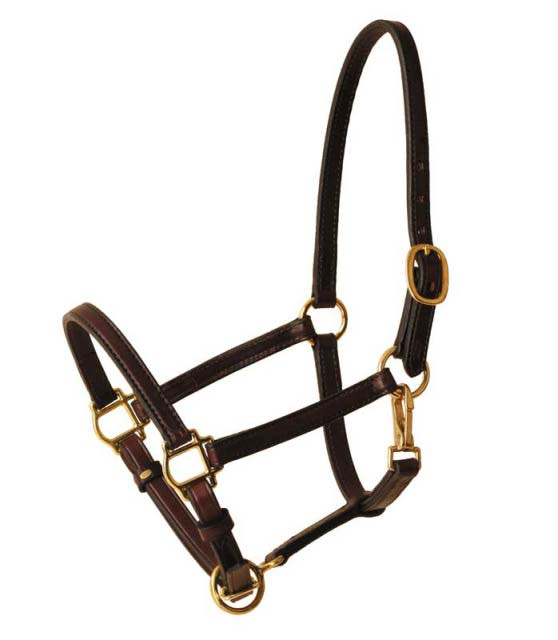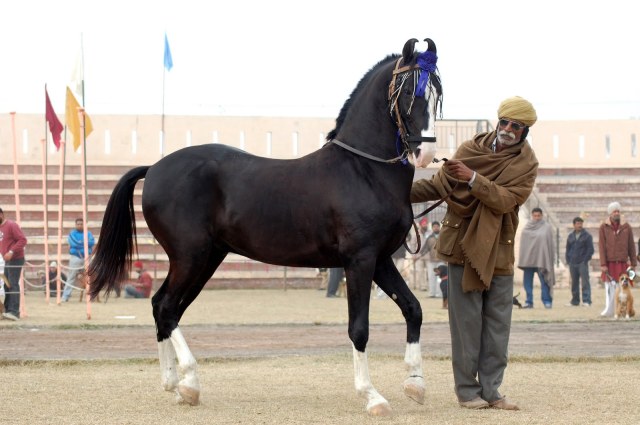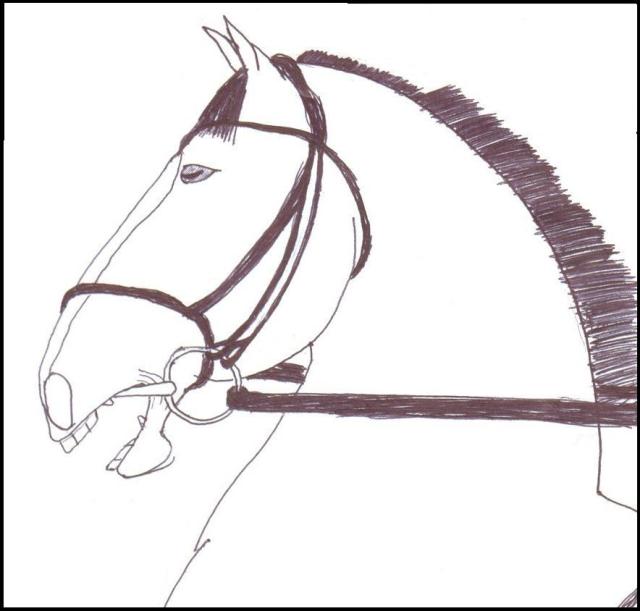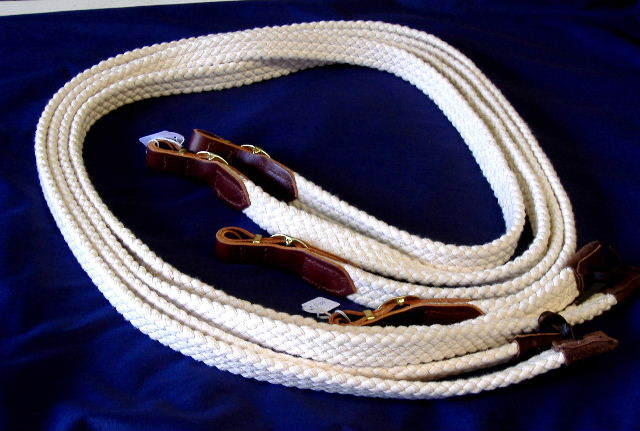QuestionHi we just adopted a 1 year old quarter horse. I have never trained a horse before. The problem i am having is that when i put the lead rope whick is 30 feet long on him and try to get him to lunge he just come towards me. How do I teach him that I want him to go in a circle around me.
AnswerIt will take practice! You may not get the desired results the first few times. The most vital and IMPORTANT key is to be patient and don't give up!
You must first ask yourself: What signal is your horse not listening to? It's the signal to move his shoulders away from you. This is the first movement we will work on. You will need a halter, leadrope and stiff, dressage-type whip (around 30-36 inches long). A long lunge whip will only get in the way at this point, but is fine to use once he has properly learned all the steps below.
LESSON ONE:
1). Standing on your horse's side, hold the leadrope about 2-4 inches from the snap (you will be facing his shoulder).
2). Use the whip to tap on the point of your horse's shoulder. Continue the steady tapping at about 1-2 taps per second.
3). As soon as your horse moves his shoulder (not his head!) away from you, immediately stop tapping. Wait 2-3 seconds and start over at step 1.
* Be sure to do this lesson from start to finish on BOTH sides of the horse!
TROUBLESHOOTING:
What if my horse doesn't move?
This is where your patience comes in. Your horse will move. It's all a matter of time, be patient and consistent with your tapping and your horse will eventually move away from the tapping. Your horse can only handle so much tapping before it becomes very annoying, so he will search for ways to get you to stop tapping.
What if he tries to face me (move his hindquarters away)?
Use the lead rope to keep his face away from you. And don't stop tapping! You don't want to stop tapping when he moves his face, shoulder or feet toward you...not even for 1 second! (see below for explanation).
What if he moves forward, back, or towards me?
If he moves forward, back or towards you, don't stop tapping! It's okay if he moves at first, he will soon realize that moving in the direction that he's going is not getting rid of that annoying tapping. He will move forward, back, toward you, and maybe even "up". The importance of you keeping consistent in your tapping is crucial to him learning the exercise properly.
What if I stop tapping before he moves in the right direction?
If you stop tapping when he is hasn't moved at all, he will learn that when you tap on his shoulder, you expect him to stand still. Thats not what you want! If you stop tapping while he's moving forward, backward or toward you, you will be teaching him that when you tap on his shoulder he should move forward, backward or toward you. You don't want that either! It is crucial that you only stop tapping when he moves in the desired direction (when his shoulder moves away from you).
How many times do I have to repeat this exercise?
Until he does it perfect every time. If it takes more than 20-30 minutes to acheive a solid result every time, then end the lesson on a good note (when he responds well several times in a row) and start again the next day.
WHY does this work?
This method works because you are sensitizing your horse. Horses have used sensitizing on eachother since the species evolved. It is natural for your horse to "search" for a way for you to stop tapping.
LESSON TWO:
Once you have the first lesson (above) down pat, continue to the second lesson (below).
1). This time hold the leadrope about 10 inches from the snap in your left hand (you will be facing his shoulder). Point to your horse's should with the whip (don't actually touch him with it). Wait 2-3 seconds.
2). If he does not move, start tapping as in lesson 1. Stop tapping the instant he moves.
3). If he moves when you point to his shoulder, stop pointing at his shoulder and bring the whip down to your side (this is good).
4). Wait 2-3 seconds and start over at step 1.
* Be sure to do this lesson from start to finish on BOTH sides of the horse!
It is important that if your horse does not respond to step 1 after 2-3 seconds have passed, you start tapping. He is learning that if he moves before you start tapping, he doesn't have to deal with the annoying feeling the whip causes on his shoulder. The first few steps may take several sessions. Don't become discouraged if he doesn't pick up on it right away.
Once he responds to you pointing at his shoulder, step back 1 ft. (away from him) and start over at step 1. If, at any time, he turns and faces you, it is an indicator that he hasn't learned the previous step thoroughly enough. You must back up a few steps and start over with only a few inches between your hand and the snap on the lead rope.
ADDITIONAL EXERCISES:
EXERCISE 1: Lets Go! On a 5-6 foot lunge circle (your hand should be less than 3 ft. from his halter), ask him to move forward by holding the whip towards his hindquarters. Once he moves, wait a few seconds and ask him to move his shoulder away from you. Alternate between the two signals until he does them both consistently.
EXERCISE 2: Yo-Yo! On a 5-6 ft. lunge circle, ask him to move his shoulder away from you. Wait a few seconds and then apply light pressure to the lead rope to ask him to come closer again. Alternate between the two signals until he does them both consistently. If, when you ask him to move closer, he turns and faces you, immediately ask him to move his shoulder away again.
EXERCISE 3: Changing Directions! On a 5-6 ft. lunge circle, apply firm pressure to the leadrope, asking him to turn and face you. Don't let him stop his feet when he turns...keep him moving. This is tricky because while he is turning, you have to switch the whip into your other hand and immediately point it to his opposite shoulder to complete the turn. Repeat from side to side until does this consistently every time.
Once your horse is able to do all of the above, you can start to make the lunge circle larger (in small increments...for example, 1 ft. larger each day). If at any time he gets confused and doesn't listen to a cue that you taught him, you'll need to go a step or two back in the training and make the circle smaller again until he does understand.
When your horse has learned these lessons, you will find that he has become a lunging PRO! It really is amazing what patience and consistency can achieve! Have FUN with it and your horse will too!

 halter
Questionhalter
QUESTION: hello sir, may i know w
halter
Questionhalter
QUESTION: hello sir, may i know w
 K K snaffle
Question
K K snaffle
hello, what are K K snaffles? is i
K K snaffle
Question
K K snaffle
hello, what are K K snaffles? is i
 please judge this horse confirmation
Question
please judge this hors
hello, this is a marwar
please judge this horse confirmation
Question
please judge this hors
hello, this is a marwar
 double whale hook
Question
double whale hook
hello maam, mos
double whale hook
Question
double whale hook
hello maam, mos
 braided reins for racing
Question
braided reins
hello sir, what are the u
braided reins for racing
Question
braided reins
hello sir, what are the u